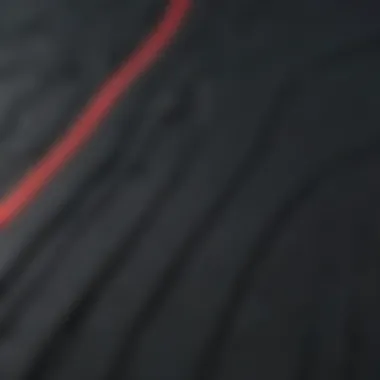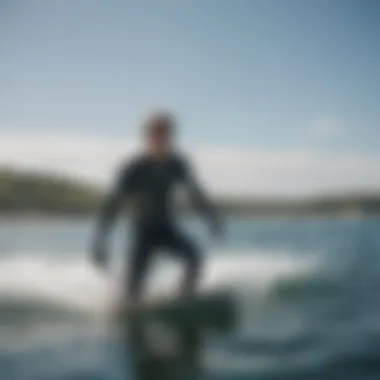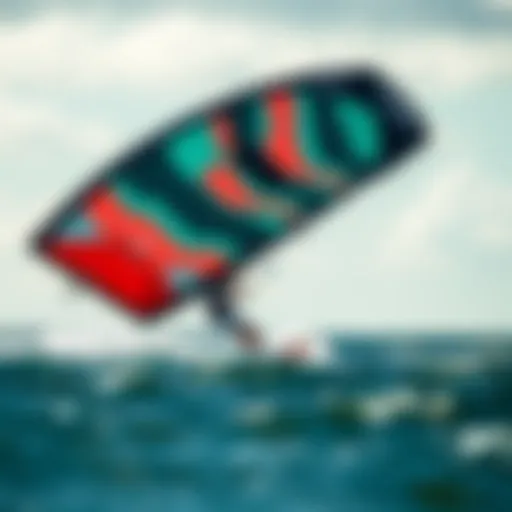Exploring Yamamoto Neoprene Wetsuits for Kiteboarding


Intro
Kiteboarding combines the thrill of surfing with the flexibility of wind power. Each rider understands that the right gear can significantly influence performance and comfort on the water. Among the myriad of choices, Yamamoto neoprene wetsuits stand out. But why is that?
Yamamoto neoprene, often regarded as a top-tier material, has gained a loyal following in the kiteboarding community. Its unique properties make it suited not just for casual use, but for intense sessions in sometimes challenging weather conditions. This discussion dives into an intricate overview of these wetsuits, delving into elements like material quality, design innovations, and the environmental implications of using such products, drawing connections to how they enhance the kiteboarding experience.
Gear Selection
Selecting the appropriate gear is no walk in the park, especially when it comes to kiteboarding. The synergy between your wetsuit and other equipment can elevate your performance to the next level. Let's break down the essentials:
Types of Kites
Choosing the right kite is crucial as it directly affects your ability to maneuver and respond to varying wind conditions. Here are some common types you might consider:
- C-kites: These are known for their sharp turns and quick response times. Ideal for freestyle tricks.
- Bow kites: With a flatter profile, they offer a lot of power for lighter wind conditions. Great for beginners.
- Delta kites: Combining features from both C-kites and bow kites, they are versatile and user-friendly.
Understanding the distinctions in kites helps kiteboarders select the best type based on their skill level and environmental conditions.
Choosing the Right Board
Your choice of board can equally impact your performance. Here are a few things to consider:
- Size: Larger boards excel in light winds and provide more stability, but can be cumbersome. Smaller boards shine in strong winds, offering greater maneuverability.
- Shape: Twin-tip boards are versatile for tricks in both directions, whereas directional boards are more suited for riding waves.
Finding the right fit between your board and kite is essential. It ensures the best riding experience, allowing you to maximize your time on the water.
Skill Development
While gear selection lays the groundwork, honing your skills is what allows kiteboarders to truly harness their capabilities. Let's explore a few aspects that come into play here:
Essential Techniques
- Body Positioning: Maintaining the right stance can enhance balance.
- Board Control: Knowing how to manipulate the board based on wind strength is vital.
- Edge Control: Proper edging can give you the lift you need during jumps.
These foundational techniques are crucial for any kiteboarder aiming to improve their performance.
Progression Tips
As with any sport, progression comes with practice and knowledge. Consider the following recommendations:
- Set Goals: Whether mastering jumps or improving speed, setting clear, attainable goals can provide motivation.
- Seek Feedback: Joining a local kiteboarding community can connect you with other enthusiasts. They can offer tips based on their own experiences.
- Stay Informed: Being aware of changes in techniques or equipment can keep you ahead of the game.
"Success in kiteboarding relies not just on equipment but also on the mastery of skills. Knowing your gear inside out prepares you for unpredictable conditions."
By assimilating knowledge about your gear and nurturing your skills, you'll find yourself on the fast track to becoming a kiteboarding guru. Through this exploration of Yamamoto neoprene wetsuits, we hope to equip you with the insights needed to enhance both your comfort and performance in the sport.
Prologue to Yamamoto Neoprene Wetsuits
In the world of kiteboarding, having the right gear can make all the difference between an exhilarating experience and a frustrating one. Among the most critical pieces of equipment, a well-designed wetsuit can enhance performance, offer protection from the elements, and add a level of comfort that is indispensable for any enthusiast. This is where Yamamoto neoprene wetsuits step into the limelight.
These wetsuits have garnered a reputation for their premium quality, innovative features, and environmental advantages, making them a go-to choice for serious kiteboarders. This section aims to shed light on the significance of Yamamoto neoprene in the broader context of kiteboarding, focusing on key elements like material quality, design features, and the unique benefits they provide.


Understanding Neoprene
Neoprene, a synthetic rubber, is the backbone of any wetsuit. But not all neoprene is created equal. The unique characteristics of Yamamoto neoprene stand out because it's produced from limestone instead of petroleum. This not only impacts its durability but also its eco-friendliness.
The lightweight nature of Yamamoto neoprene contributes to the overall user experience in kiteboarding. Its thermal properties aid in maintaining body warmth, even when you’re splashing about in chilly waters. Here’s a quick breakdown of how these features serve kiteboarders:
- Insulation: Retains warmth while allowing movement.
- Flexibility: Offers a snug fit, crucial for various maneuvers.
- Durability: Resists wear and tear better than its conventional counterparts.
Understanding these factors is essential for any serious kiteboarder aiming to up their game.
Historic Perspective on Yamamoto Materials
Yamamoto Corporation has been around since the mid-20th century, gradually establishing itself as a leader in wetsuit materials. The company’s journey began with a commitment to develop a high-quality neoprene that not only meets performance demands but also aligns with sustainability goals.
Over the decades, Yamamoto has introduced several innovations, such as:
- Eco-Friendly Production: Transitioning from petroleum to limestone-based neoprene.
- Advanced Manufacturing Techniques: These enhance water resistance and insulation properties.
- Support for Athletes: Collaborations with kiteboarding pros, allowing for feedback-driven improvements.
Yamamoto’s ongoing dedication to both high performance and environmental responsibility puts it at the forefront of the wetsuit market. This historical context is crucial to understanding not just the materials themselves, but also how they evolved to become an integral part of the kiteboarding community.
As we delve deeper into this article, the exploration of Yamamoto neoprene’s key features will further illustrate why it is beloved by kiteboarders around the globe.
Key Features of Yamamoto Neoprene
Understanding the key features of Yamamoto neoprene wetsuits is paramount, especially for kiteboarders who require optimal performance and durability from their gear. Each attribute plays a significant role in delivering a comfortable yet efficient riding experience. From the craftsmanship of the materials to the advanced design aspects, these suits distinguish themselves in a crowded market. Let’s dissect the core elements that set Yamamoto neoprene apart, focusing on aspects vital for enthusiasts and professionals alike.
Material Composition and Innovation
The heart of Yamamoto neoprene lies in its superior material composition. Unlike conventional neoprene, which is often derived from petroleum, Yamamoto uses a natural limestone-based formulation. This innovative approach not only enhances the flexibility and buoyancy of the wetsuits but also significantly reduces the environmental impact. The unique cellular structure formed during the curing process allows the material to maintain better insulation properties, ensuring warmth without the bulkiness associated with traditional wetsuits.
In practical terms, kiteboarders will notice that these suits provide an exceptional fit and glide through water seamlessly, thanks to their lightweight nature. The state-of-the-art production techniques also result in a higher tensile strength, leading to less likelihood of tearing or wear, which is a frequent concern during high-adrenaline activities like kiteboarding.
Thermal Insulation Properties
One of the prime concerns when engaging in any water sport is thermal insulation. Yamamoto neoprene excels in this area, providing an effective barrier against cold water. The thermal properties are directly linked to the thickness of the material, usually ranging from 3mm to 5mm depending on the model and intended water temperature. This unique composition traps air within its cellular structure, which acts as a natural insulator – keeping you warm even in chilly conditions.
Moreover, the suits tend to maintain consistent body temperature during active movements, eliminating the clammy feeling that can come with other neoprene suits. In colder waters, this is an absolute game-changer for performance, allowing kiteboarders to stay out on the waves longer without feeling the bite of cold water.
"A well-fitted Yamamoto wetsuit keeps your body warm and your mind focused on the thrill of the ride, not on the cold."
Flexibility and Comfort
When it comes to kiteboarding, flexibility can make or break your performance. Yamamoto neoprene is specifically engineered for high flexibility, allowing for a full range of motion without constriction. The suit molds effortlessly to the body, making it feel almost like a second skin. This is especially crucial when kiteboarding, where the movements are dynamic and require quick reflexes.
Aside from flexibility, comfort plays a frictionless role in overall enjoyment. Yamamoto wetsuits often feature smooth interiors, which glide on the skin and minimize chafing — a notorious issue with poorly designed wetsuits. The careful tailoring and thoughtful placements of seams further enhance comfort, meaning less time spent fussing over your gear and more time enjoying the exhilaration of riding the wind and waves.
Design Considerations in Yamamoto Wetsuits
The design of Yamamoto wetsuits plays a pivotal role for kiteboarders seeking optimal performance. Given the sport's unique demands—often involving rapid movements, exposure to varying water temperatures, and the necessity for agility—a well-thought-out wetsuit design can significantly impact user experience. From materials to construction techniques, thoughtful design consideration enhances functionality, comfort, and durability. Let's delve deeper into the critical aspects of Yamamoto wetsuit design.
Fit and Sizing Options


Achieving the right fit is one of the most crucial aspects of choosing a Yamamoto wetsuit. A wetsuit that's too loose can lead to water entry, making it difficult to maintain warmth, while a suit that's too tight can hinder movement, leading to discomfort.
Yamamoto wetsuits are available in a variety of sizes, catering to different body types. It's important to measure carefully, focusing on key indicators like chest, waist, and inseam. The brand often provides detailed sizing charts, guiding customers to find the best match for their physique.
In addition, many models feature flexible designs. For instance, some wetsuits come with adjustable cuffs or stretch panels that allow for a personalized feel. This flexibility not only enhances comfort but also accommodates dynamic movements—an essential trait for kiteboarding.
Seam Technology and Construction
The seams in wetsuits are not just a detail; they are a critical component that affects water resistance and comfort. Yamamoto wetsuits utilize advanced seam technologies, such as bonded seams and tape sealing methods, which ensure minimal water penetration. This technology not only keeps the wearer warm and dry but also provides durability over time.
A specific highlight is the use of blind stitching, where the needle does not penetrate all the way through the neoprene. This technique creates a flatter seam, minimizing chafing and enhancing flexibility. When kiteboarding, this means less irritation, allowing the athlete to stay focused on performance rather than discomfort.
Closure Systems and Entry Points
Yamamoto wetsuits are meticulously designed with a variety of closure systems tailored for ease of use and effectiveness. The most common systems include back zippers, front zippers, and no-zip designs, each offering unique benefits:
- Back Zipper: Provides a secure fit and is often easier to don and doff for many users.
- Front Zipper: Often favored for added flexibility in the shoulder area, resulting in enhanced arm mobility for kiteboarders.
- No-Zip Design: Features a stretch entry point that ensures a snug fit while maximizing movement, eliminating the need for bulky zippers.
These entry points contribute significantly to the overall user experience, allowing athletes to transition quickly and comfortably while suiting up for their adventures on the water.
"The right wetsuit can change the game. When kiteboarding, comfort is key; a thoughtful design gives you the confidence to push your limits."
By effectively integrating these design elements, Yamamoto ensures that their wetsuits meet the complexities of kiteboarding, offering a blend of comfort, flexibility, and durability that enhances the water sports experience.
Performance Analysis of Yamamoto Wetsuits in Kiteboarding
The performance analysis of Yamamoto wetsuits, particularly in kiteboarding, is crucial for both enthusiasts and serious competitors. In a sport that relies heavily on agility, control, and climate conditions, the right wetsuit can make a world of difference. Understanding how these wetsuits perform under various real-world conditions not only helps kiteboarders to make informed decisions but also ensures safety and comfort while out on the water.
When contemplating the performance of a wetsuit, several factors come into play: thermal regulation, flexibility, and overall durability. Yamamoto’s innovative materials are specially designed for performance, aimed at delivering an experience that aligns with the dynamic nature of kiteboarding. As such, an in-depth look into real-world testing and performance metrics is paramount.
Real-World Testing and Feedback
Yamamoto neoprene wetsuits have undergone rigorous real-world testing, both in controlled environments and during actual kiteboarding sessions. Testers, often professionals or seasoned enthusiasts, have provided feedback that reveals how the wetsuits perform in various conditions.
- Temperature Variability: Kiteboarders often face fluctuating temperatures. Feedback indicates that Yamamoto wetsuits maintain body warmth even in chilly water, thanks to advanced thermal insulation technology. Importantly, these suits manage to prevent overheating when the weather warms up.
- Mobility and Range of Motion: Many kiteboarders have noted how Yamamoto wetsuits allow for a full range of movement, essential for jumps and tricks. The material’s elasticity plays a critical role here. Users have reported minimal resistance when performing dynamic maneuvers, highlighting the suit's superior design.
- Durability and Wear: Feedback from users also emphasizes the longevity of Yamamoto wetsuits. Several testers shared experiences of regular use for multiple seasons without significant deterioration. This aspect is particularly valuable for those heavily invested in the sport, as it reduces the frequency of replacement costs.
- Real-Life Scenarios: Users often recount experiences under diverse conditions—from sunny days to stormy weather—where the suits performed admirably. Their resilience against water ingress and wind chill is a common theme in user testimonials.
"You feel like you’re wearing a second skin. No tugging, no poking; just pure freedom!"
– Kiteboarding Enthusiast
Comparative Performance Metrics
To truly appreciate the performance of Yamamoto wetsuits, a comparative approach can also yield valuable insights. The metrics used for comparison include:
- Insulation Efficiency: Compared to traditional neoprene suits, Yamamoto materials are often evaluated for their insulating properties. Users frequently notice that these suits retain heat much better, making them suitable even for longer sessions in colder waters.
- Weight Consideration: Many kiteboarders have pointed out that Yamamoto wetsuits feel significantly lighter than their counterparts without compromising on warmth or flexibility. This weight difference can lead to less fatigue over long sessions.
- Flexibility Ratings: A common industry standard is how much a wetsuit stretches. Reviews have indicated that Yamamoto’s neoprene boasts superior stretchability, allowing for more dynamic range in kiteboarding moves.
- Customer Satisfaction Scores: Online platforms often show high satisfaction ratings among users of Yamamoto wetsuits. Despite a higher price point than standard wetsuits, many agree that the performance benefits justify the investment.
In examining these comparisons, it's clear that Yamamoto wetsuits stand out in various critical performance areas. The accolades received from kiteboarding communities underscore the efficacy and reliability of these suits in maximizing enjoyment and performance on the water.
Environmental Impact of Yamamoto Neoprene
The significance of exploring the environmental impact of Yamamoto neoprene in this article cannot be overstated. As kiteboarding gains popularity, so does the scrutiny regarding the ecological footprint of the materials used in sporting gear. Yamamoto neoprene, being a material that promises both performance and sustainability, deserves a closer look. Kiteboarders today are not only athletes but also advocates for the environment, striving to make choices that align with their values. Mentioning the sustainability factor significantly informs potential buyers about their purchases, allowing them to align their sporting goods with responsible practices.
Sustainability in Materials Production


Yamamoto neoprene is made from limestone, a natural resource, distinguishing it from traditional neoprene derived from petroleum. This transformation from raw limestone to a functional, high-quality wetsuit material is not just a simple process; it represents a commitment to reduced environmental harm. The production process is designed to minimize waste, featuring a closed-loop operation that prevents pollution from reaching the atmosphere and waterways.
Additionally, the fabric boasts a significantly lower carbon footprint when compared to its petroleum-based counterpart. This is crucial as the impact of climate change looms larger. Not having to rely on non-renewable resources means that kiteboarders can enjoy their sport while lessening their environmental toll.
"Buying gear that causes less harm to our planet can make a wave of difference, one wetsuit at a time."
It's worth noting, however, that sustainable production also doesn't come at the cost of quality. Yamamoto neoprene fulfills rigorous performance benchmarks while being crafted through environmentally friendly measures. This combination of sustainability and performance solidifies its place among kiteboarding enthusiasts who value eco-friendliness without compromising on their gear quality.
Recycling and End-of-Life Options
A cornerstone of an eco-conscious approach is not just in the making but also in what happens after a product reaches the end of its useful life. Yamamoto neoprene shines here too. Unlike much of its synthetic peers, which typically end up in landfills, Yamamoto neoprene is designed with recycling in mind.
Various programs have emerged to facilitate the recycling process of used wetsuits, including initiatives by manufacturers that actively encourage returning old suits for proper recycling. The material can be broken down and transformed into new wetsuits or other useful products, reducing the waste on our planet. As Kiteboarders, embracing this option contributes to a circular economy.
Moreover, potential end-of-life options can also include repurposing the suits for different uses, such as crafting pet products or upcycling into artistic endeavors. These creative recycling methods showcase the versatility of Yamamoto neoprene and its capacity to persist in new forms, thereby extending its functional lifecycle and reducing environmental impact overall.
Maintenance and Care for Yamamoto Wetsuits
Caring for your Yamamoto wetsuit is not just about keeping it looking good. It’s about maintaining the functionality and extendng its lifespan. Kiteboarding can be tough on gear, and a well-maintained wetsuit is crucial for optimal performance on the water. This section dives into various aspects of maintenance and care, spotlighting cleaning techniques and proper storage methods. By understanding and executing these practices, you ensure that your wetsuit remains a dependable piece of equipment throughout many kiteboarding adventures.
Cleaning Techniques and Recommendations
After a long day on the water, your wetsuit might come back looking like it survived a tidal wave. Saltwater, sand, and other grime can accumulate on the suit, making it essential to clean it properly. Here are some effective cleaning techniques to follow:
- Rinse Immediately: As soon as you finish your session, rinse your wetsuit with fresh water. This helps to remove salt, sand, and other residues that might cling if left untreated.
- Gentle Soap: Use a mild wetsuit cleaner or a gentle soap. Harsh chemicals can degrade the neoprene over time, so stick to products specifically designed for wetsuits.
- Cold Water Only: Always wash your wetsuit in cold water. Hot water can cause the neoprene to lose its flexibility and insulation properties.
- Avoiding Excessive Pressure: When rinsing or scrubbing, don't be too rough. Neoprene can be sensitive to pressure; use light hands to prevent damage.
- Drying Without Heat: After rinsing, hang your wetsuit inside out on a wide hanger to dry in a shaded area, away from direct sunlight. Avoid any harsh heat sources that could warp the material.
"A little care goes a long way; keep your gear in mind and it will certainly serve you well!"
Storage and Longevity Practices
When it comes to how you store your Yamamoto wetsuit, think of it as tucking your gear in for a good night’s sleep. Proper storage practices can help maintain its shape and condition. Here are key practices to adopt:
- Store Flat or Hanging: If possible, store your wetsuit flat, but if you must hang it, use a thick, wide hanger. This prevents unnecessary creases and stretching.
- Cool and Dry Place: Ensure that your storage area is cool and dry. Favor a space with good ventilation to prevent mold and mildew from developing.
- Avoid Compression: Don’t squash your wetsuit under heavy items. Weight can crumple the material, which affects both fit and insulation.
- Wrap It Up: Consider using a garment bag for long-term storage. This will help protect the suit from dust and potential damage.
By following these cleaning and storage guidelines, you not only enhance the durability of your Yamamoto wetsuit but also contribute to overall performance and comfort during kiteboarding sessions. A well-cared-for wetsuit is an investment in both your enjoyment and safety on the water.
Ending and Recommendations
When it comes to kiteboarding, selecting the right wetsuit can make or break your experience on the water. This final section synthesizes the extensive discussion from previous sections, emphasizing the unique advantages that Yamamoto neoprene wetsuits offer. It explores how these elements play into the decision-making process for both novice and seasoned kiteboarders alike.
The importance of thoroughly evaluating personal needs cannot be understated. The diverse nature of kiteboarding often means that individuals require varying features—some may prioritize warmth, while others might focus on flexibility or ease of movement. Yamamoto wetsuits score high on almost all fronts, thanks to their innovative designs and material quality. This versatility ensures that there’s likely a suitable model within their lineup, no matter the conditions or the rider's preferences.
Furthermore, there’s a significant appeal in their eco-friendliness, providing an edge in today’s environmentally conscious market. Consumers are increasingly concerned about the impact of their purchases, and Yamamoto neoprene shines here, aligning well with the ideals of sustainability. This aspect not only enhances the value of the wetsuit but also offers peace of mind to the user, knowing that they’re contributing to a healthier planet.
"A wetsuit is more than just gear; it’s your second skin that enhances performance and comfort on the water."
Evaluating Personal Needs
When deciding on a wetsuit, it’s crucial to take stock of individual requirements. Here’s a breakdown of important factors to consider:
- Water Temperature: Consider the climate you’ll be kiteboarding in. Yamamoto provides a range of thickness options to retain warmth without unnecessary bulk. If you’re often in tropical waters, a thinner suit may be appropriate, while colder climates necessitate a thicker option.
- Mobility and Flexibility: Evaluate your level of activity and style within kiteboarding. For the more dynamic maneuvers, investing in a suit with maximum stretch and flexibility is essential. The Yamamoto neoprene excels in this area, often cited for its unparalleled movement.
- Duration in Water: If you plan on long sessions, comfort is key. Weighting in on seam construction and fit ensures that you can enjoy extended time in the water without discomfort.
- Budget Considerations: While Yamamoto wetsuits may be pricier than conventional options, their durability and performance often justify the investment. It’s a wise decision to view this as a long-term gain rather than immediate expense.
Final Thoughts on Yamamoto Wetsuits
In summary, these wetsuits offer a cornucopia of benefits that cater to the nuanced demands of kiteboarding enthusiasts. From the material technology that prioritizes thermal insulation and flexibility to the responsible choices in manufacturing, it’s clear why many riders gravitate toward them.
While trends come and go, the steadfast performance of Yamamoto neoprene in the field ensures that it holds a place of respect among various seasons and riding styles. Riders not only gain a wetsuit that works exceptionally well but one that contributes positively to environmental sustainability.
In closing, Yamamoto neoprene wetsuits provide kiteboarders with a blend of comfort, performance, and eco-consciousness that is hard to ignore. Whatever your personal preferences or specific requirements, taking the plunge into a Yamamoto suit is likely to enhance your kiteboarding journey significantly.















